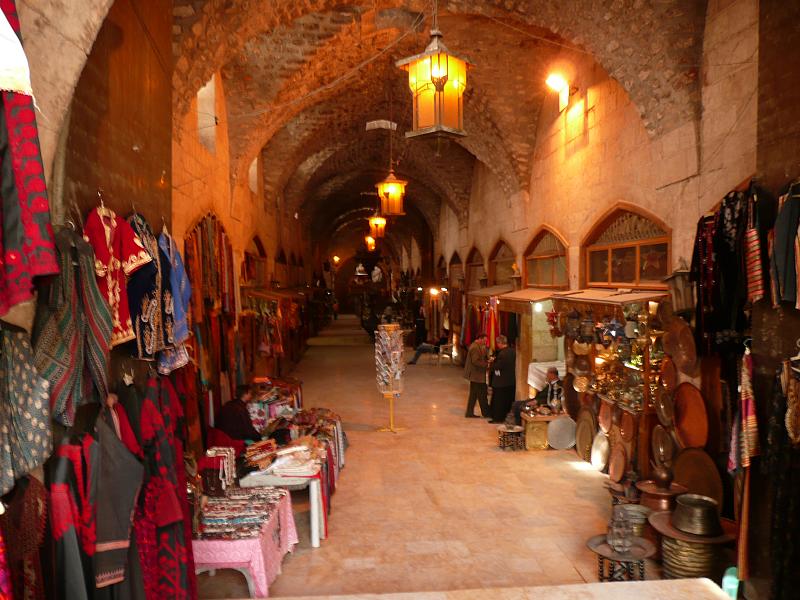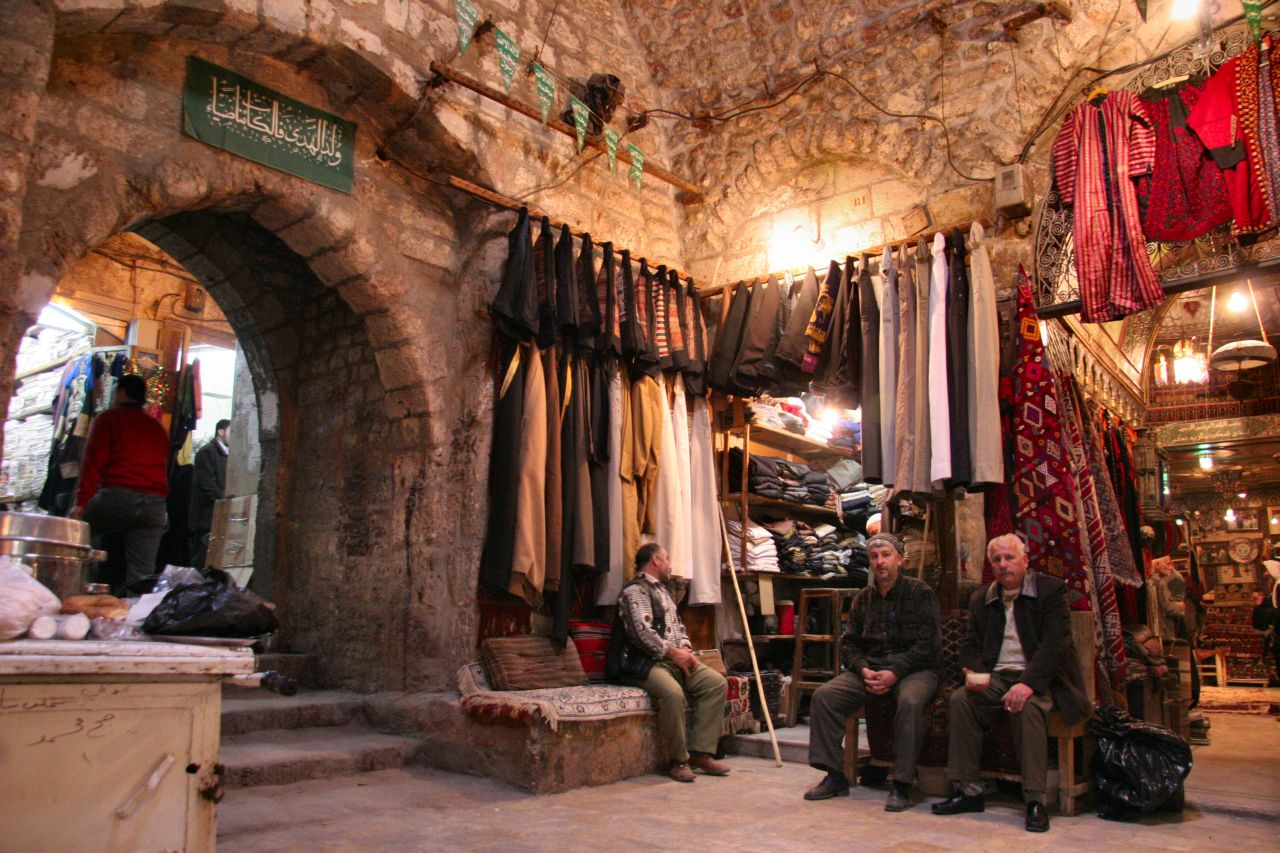Al-Madina Souq on:
[Wikipedia]
[Google]
[Amazon]
Al-Madina Souq ( ar, سوق المدينة, Sūq al-Madīna) is the covered souq-market located at the heart of the Syrian city of Aleppo within the walled ancient part of the city. With its long and narrow alleys, al-Madina Souq is the largest covered historic market in the world, with an approximate length of 13 kilometers. It is a major trade centre for imported luxury goods, such as raw silk from


 The city's strategic trading position attracted settlers of all races and beliefs who wished to take advantage of the commercial roads that met in Aleppo from as far as China and
The city's strategic trading position attracted settlers of all races and beliefs who wished to take advantage of the commercial roads that met in Aleppo from as far as China and
File:Suq al-Attarine2.jpg, Souq al-Attareen
File:Aleppo view from the suq al-Madinah.jpg, Souq al-Farrayin
File:Aleppo, textile suq market.jpg, Souq al-Hiraj
File:Suq al-Atmah, al-Madina Souq, Aleppo (1).jpg, Souq al-'Atmah
File:Suq az-Zirb Aleppo.JPG, Souq az-Zirb
3-D Old Aleppo mapAleppo news and services (eAleppo)Organization of World Heritage CitiesErnst Herzfeld Papers, Series 5: Drawings and Maps, Records of Aleppo
Collections Search Center, S.I.R.I.S., Smithsonian Institution, Washington, D.C.
*Forbes, Andrew, and Henley, David
''Aleppo's Great Bazaar''
(CPA Media) {{Aleppo landmarks Souqs Aleppo Historic sites in Syria Architecture in Syria
Iran
Iran, officially the Islamic Republic of Iran, and also called Persia, is a country located in Western Asia. It is bordered by Iraq and Turkey to the west, by Azerbaijan and Armenia to the northwest, by the Caspian Sea and Turkmeni ...
, spices and dyes from India
India, officially the Republic of India (Hindi: ), is a country in South Asia. It is the seventh-largest country by area, the second-most populous country, and the most populous democracy in the world. Bounded by the Indian Ocean on the so ...
and many other products. Al-Madina Souq is also home to local products such as wool, agricultural products and soap. Most of the souqs date back to the 14th century and are named after various professions and crafts, hence the wool souq, the copper souq, and so on. Aside from trading, the souq accommodated the traders and their goods in ''khan''s (caravanserais
A caravanserai (or caravansary; ) was a roadside inn where travelers ( caravaners) could rest and recover from the day's journey. Caravanserais supported the flow of commerce, information and people across the network of trade routes covering ...
) scattered within the souq. Other types of small market-places were called caeserias (قيساريات). Caeserias are smaller than khans in size and functioned as workshops for craftsmen. Most of the khans took their names after their function and location in the souq, and are characterized by beautiful façades and entrances with fortified wooden doors.
Al-Madina Souq is part of the Ancient City of Aleppo
The Ancient City of Aleppo ( ar, مدينة حلب القديمة, Madīnat Ḥalab al-Qadīma) is the historic city centre of Aleppo, Syria. Before the Syrian Civil War, many districts of the ancient city remained essentially unchanged since ...
, a UNESCO World Heritage Site
A World Heritage Site is a landmark or area with legal protection by an international convention administered by the United Nations Educational, Scientific and Cultural Organization (UNESCO). World Heritage Sites are designated by UNESCO for ...
since 1986.
Many sections of the souq and other medieval buildings in the ancient city were destroyed, ruined or burnt as a result of fighting between the Syrian opposition and the Syrian Armed Forces beginning on 25 September 2012.
Souqs and khans

Mesopotamia
Mesopotamia ''Mesopotamíā''; ar, بِلَاد ٱلرَّافِدَيْن or ; syc, ܐܪܡ ܢܗܪ̈ܝܢ, or , ) is a historical region of Western Asia situated within the Tigris–Euphrates river system, in the northern part of the ...
to the east, Europe
Europe is a large peninsula conventionally considered a continent in its own right because of its great physical size and the weight of its history and traditions. Europe is also considered a subcontinent of Eurasia and it is located entirel ...
to the west, and the Fertile Crescent
The Fertile Crescent ( ar, الهلال الخصيب) is a crescent-shaped region in the Middle East, spanning modern-day Iraq, Syria, Lebanon, Israel, Palestine and Jordan, together with the northern region of Kuwait, southeastern region of ...
and Egypt
Egypt ( ar, مصر , ), officially the Arab Republic of Egypt, is a transcontinental country spanning the northeast corner of Africa and southwest corner of Asia via a land bridge formed by the Sinai Peninsula. It is bordered by the Medit ...
to the south.
The most significant souqs within and along the covered area of Souq al-Madina:
*''Khan al-Qadi'', one of the oldest khans in Aleppo dating back 1450.
*''Khan al-Burghul'' (or bulgur
Bulgur (from tr, bulgur, itself from fa, بلغور, bolġur (bolghur)/balġur (balghur), groats ), also riffoth (from biblical he, ריפות, riffoth) and burghul (from ar, برغل, burġul ), is a cracked wheat dish found ...
), built in 1472, hosted the British general consulate of Aleppo until the beginning of the 20th century.
*''Souq al-Saboun'' or the soap khan, built in the beginning of the 16th century. It is one of the main centres of the Aleppo soap production.
*''Souq Khan al-Nahhaseen'' or the coopery souq, built in 1539. It hosted the general consulate of Belgium
Belgium, ; french: Belgique ; german: Belgien officially the Kingdom of Belgium, is a country in Northwestern Europe. The country is bordered by the Netherlands to the north, Germany to the east, Luxembourg to the southeast, France to th ...
during the 16th century. Nowadays, it is known for its traditional and modern shoe-trading shops with 84 stores.
*''Khan al-Shouneh'', built in 1546. Currently functions as a market for trades and traditional handicrafts of Aleppine art.
*''Souq Khan al-Jumrok'' or the customs' khan, a textile trading centre with 55 stores. Built in 1574, Khan Al-Gumrok is considered to be the largest khan in ancient Aleppo.
*''Souq Khan al-Wazir'', built in 1682, believed to be the main souq of cotton products in Aleppo.
*''Souq al-Farrayin'' or the fur
Fur is a thick growth of hair that covers the skin of mammals. It consists of a combination of oily guard hair on top and thick underfur beneath. The guard hair keeps moisture from reaching the skin; the underfur acts as an insulating blanket t ...
market, is the main entrance to the souq from the south. The souq is home to 77 stores mainly specialized in furry products.
*''Souq al-Hiraj'', traditionally was the main market of firewood and charcoal. Currently, it has 33 stores mainly dealing in rug and carpet
A carpet is a textile floor covering typically consisting of an upper layer of pile attached to a backing. The pile was traditionally made from wool, but since the 20th century synthetic fibers such as polypropylene, nylon, or polyester hav ...
products.
*''Souq al-Dira, a large centre of tailoring and one of the most organized alleys in the souq with its 59 workshops.
*''Souq al-Attareen'' or the herbals' market. Traditionally, was the main spice-selling market of Aleppo. Currently, it is functioning as a textile-selling centre with 82 stores, including a few spice-selling shops.
*''Souq az-Zirb'', originally known as Souq ad-Dharb, is the main entrance to the souq from the east. Was a place where coins were being struck during the Mamluk period. Nowadays, the souq has 71 shops, most of them deal with textiles and the basic needs of the Bedouins
The Bedouin, Beduin, or Bedu (; , singular ) are nomadic Arab tribes who have historically inhabited the desert regions in the Arabian Peninsula, North Africa, the Levant, and Mesopotamia. The Bedouin originated in the Syrian Desert and Ar ...
.
*''Souq al-Behramiyeh'', located near the Behramiyeh mosque with 52 stores trading in foodstuffs.
*''Souq Marcopoli'' (derived from the family name of Marcopoli, the hereditary Italian consuls in Aleppo), a center of textile trading with 29 stores.
*''Souq al-Atiq'' or the old souq, specialized in raw leather trading with 48 stores.
*''Souq as-Siyyagh'' or the jewelry market, is the main centre of jewelry shops in Aleppo and Syria with 99 stores located in 2 parallel alleys.
*''The Venetians' Khan'', was home to the consul of Venice
Venice ( ; it, Venezia ; vec, Venesia or ) is a city in northeastern Italy and the capital of the Veneto region. It is built on a group of 118 small islands that are separated by canals and linked by over 400 bridges. The isla ...
and the Venetian merchants.
*''Souq an-Niswan'' or the women's market, the place where all necessary accessories, clothes and wedding equipments of the bride could be found.
*''Souq Arslan Dada'', is one of the main entrances to the walled city from the north. With 33 stores, the souq is a centre of leather
Leather is a strong, flexible and durable material obtained from the tanning, or chemical treatment, of animal skins and hides to prevent decay. The most common leathers come from cattle, sheep, goats, equine animals, buffalo, pigs and hog ...
and textile trading.
*''Souq al-Haddadin'', is one of the northern entrances to the old city. Located outside the main considered to be the old traditional blacksmiths' market with its 37 workshops.
*''Souq Khan al-Harir'' or the silk khan, is another entrance to the old city from the north. Built in the second half of the 16th century, the khan has 43 stores mainly specialized in textile
Textile is an umbrella term that includes various fiber-based materials, including fibers, yarns, filaments, threads, different fabric types, etc. At first, the word "textiles" only referred to woven fabrics. However, weaving is not the ...
trading. It hosted the Iranian consulate until 1919.
*''Suweiqa'' (for small souq in Arabic
Arabic (, ' ; , ' or ) is a Semitic language spoken primarily across the Arab world.Semitic languages: an international handbook / edited by Stefan Weninger; in collaboration with Geoffrey Khan, Michael P. Streck, Janet C. E.Watson; Walter ...
), consists of 2 long alleys: Sweiqat Ali and Suweiqat Hatem, located in al-Farafira district, home to a group of khans and markets mainly specialized in home and kitchen equipment.
Gallery
See also
* Al-Hamidiyah Souq of DamascusReferences
External links
3-D Old Aleppo map
Collections Search Center, S.I.R.I.S., Smithsonian Institution, Washington, D.C.
*Forbes, Andrew, and Henley, David
''Aleppo's Great Bazaar''
(CPA Media) {{Aleppo landmarks Souqs Aleppo Historic sites in Syria Architecture in Syria